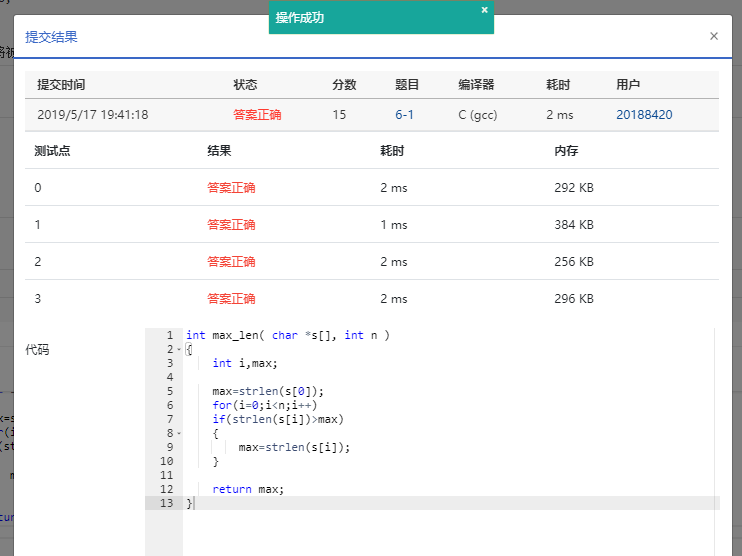| 这个作业属于那个课程 | C语言程序设计II |
| 这个作业要求在哪里 | https://edu.cnblogs.com/campus/zswxy/MS/homework/3239 |
| 我在这个课程的目标是 | 理解指针和函数的关系、链表的相关知识 |
| 这个作业在那个具体方面帮助我实现目标 | 对链表的增添、删减和修改 |
| 参考文献 | C语言教科书和百度 |
6-1 计算最长的字符串长度 (15 分)
本题要求实现一个函数,用于计算有n个元素的指针数组s中最长的字符串的长度。
函数接口定义:
int max_len( char *s[], int n );
其中n个字符串存储在s[]中,函数max_len应返回其中最长字符串的长度。
裁判测试程序样例:
#include <stdio.h>
#include <string.h>
#include <stdlib.h>
#define MAXN 10
#define MAXS 20
int max_len( char *s[], int n );
int main()
{
int i, n;
char *string[MAXN] = {NULL};
scanf("%d", &n);
for(i = 0; i < n; i++) {
string[i] = (char *)malloc(sizeof(char)*MAXS);
scanf("%s", string[i]);
}
printf("%d\n", max_len(string, n));
return 0;
}
/* 你的代码将被嵌在这里 */
输入样例:
4
blue
yellow
red
green
输出样例:
6
实验代码:
int max_len( char *s[], int n )
{
int i,max;
max=strlen(s[0]);
for(i=0;i<n;i++)
if(strlen(s[i])>max)
{
max=strlen(s[i]);
}
return max;
}
设计思路:

遇到的问题及解决方案:
挺简单的,没什么大问题。别人的的代码我也看了几个,大家方法都差不多,大同小异。
运行结果截图:

6-2 统计专业人数 (15 分)
本题要求实现一个函数,统计学生学号链表中专业为计算机的学生人数。链表结点定义如下:
struct ListNode {
char code[8];
struct ListNode *next;
};
这里学生的学号共7位数字,其中第2、3位是专业编号。计算机专业的编号为02。
函数接口定义:
int countcs( struct ListNode *head );
其中head是用户传入的学生学号链表的头指针;函数countcs统计并返回head链表中专业为计算机的学生人数。
裁判测试程序样例:
#include <stdio.h>
#include <stdlib.h>
#include <string.h>
struct ListNode {
char code[8];
struct ListNode *next;
};
struct ListNode *createlist(); /*裁判实现,细节不表*/
int countcs( struct ListNode *head );
int main()
{
struct ListNode *head;
head = createlist();
printf("%d\n", countcs(head));
return 0;
}
/* 你的代码将被嵌在这里 */
输入样例:
1021202
2022310
8102134
1030912
3110203
4021205
#
输出样例:
3
实验代码:
int countcs( struct ListNode *head )
{
int num=0;
while(head!=NULL)
{
if(head->code[1]=='0'&&head->code[2]=='2')
num++;
head=head->next;
}
return num;
}
设计思路:

遇到的问题及解决方案:
问题:最初想的代码是老师讲的用p指针循环,
int countcs( struct ListNode *head )
{
int num=0;
struct ListNode *p;
p=head;
while(p!=NULL)
{
if(head->code[1]=='0'&&head->code[2]=='2')
num++;
p=head->next;
}
return num;
}
但是,运行超时了。
方案:不要p,直接用head来循环。
运行结果截图:


6-3 删除单链表偶数节点 (20 分)
本题要求实现两个函数,分别将读入的数据存储为单链表、将链表中偶数值的结点删除。链表结点定义如下:
struct ListNode {
int data;
struct ListNode *next;
};
函数接口定义:
struct ListNode *createlist();
struct ListNode *deleteeven( struct ListNode *head );
函数createlist从标准输入读入一系列正整数,按照读入顺序建立单链表。当读到−1时表示输入结束,函数应返回指向单链表头结点的指针。
函数deleteeven将单链表head中偶数值的结点删除,返回结果链表的头指针。
裁判测试程序样例:
#include <stdio.h>
#include <stdlib.h>
struct ListNode {
int data;
struct ListNode *next;
};
struct ListNode *createlist();
struct ListNode *deleteeven( struct ListNode *head );
void printlist( struct ListNode *head )
{
struct ListNode *p = head;
while (p) {
printf("%d ", p->data);
p = p->next;
}
printf("\n");
}
int main()
{
struct ListNode *head;
head = createlist();
head = deleteeven(head);
printlist(head);
return 0;
}
/* 你的代码将被嵌在这里 */
输入样例:
1 2 2 3 4 5 6 7 -1
输出样例:
1 3 5 7
实验代码:
设计思路:



参考了:https://www.cnblogs.com/jk-liulei/p/10877438.html
运行结果截图:

学习进度条


学习感悟:
学习还是要及时复习,只靠课堂,感觉越来越吃力,要增加平时学习的时间;还有,有些人学习挺不错的,要多多向他们请教。

